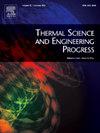Development and validation of innovative hot water spray defrosting method
IF 5.1
3区 工程技术
Q2 ENERGY & FUELS
引用次数: 0
Abstract
One of the most common problems in refrigeration cycles is the failure to defrost the evaporator, resulting in decreased performance. This study proposes the hot water defrosting approach as an alternative to the defrosting process using hot gas, an electric heater, and airflow. For this purpose, a hot water box was designed to use the heat from the compressor discharge line, which contains finned tubes through which R290 (propane) refrigerant flows for defrosting. In addition, a defrost control method algorithm was established. The best coefficient of performance (COP) of 4.34 was obtained in Exp. 3. The highest defrosting efficiency was 58.79 % for the hot water defrosting method, while the lowest value was 28.29 % for the airflow. It was observed that the defrosting time could be shortened by using the hot water method, better energy usage could be achieved by using Exp. 4, and a more effective defrosting efficiency could be achieved by using Exp. 5. It was determined that the hot water method can create a difference of up to 44 % in defrost efficiency compared to the hot gas method. Moreover, it was determined that the new approach has almost the same performance compared to the reverse cycle method, but it can provide an advantage because it is not exposed to sudden pressure fluctuations and mechanical shocks. Despite the modest return on investment (0.56–2.22 years) and sustainability for as long as the system is in use, the risk of corrosion that may occur over time during the hot water spraying process should be considered.
新型热水喷雾除霜方法的开发与验证
制冷循环中最常见的问题之一是蒸发器除霜失败,导致性能下降。本研究提出热水除霜方法作为使用热气体、电加热器和气流的除霜过程的替代方法。为此,设计了一个热水箱来利用压缩机排放管道的热量,该管道包含R290(丙烷)制冷剂流经的翅片管来除霜。此外,建立了除霜控制方法算法。试验3的最佳性能系数(COP)为4.34。热水法除霜效率最高为58.79%,气流法除霜效率最低为28.29%。实验结果表明,热水法可以缩短除霜时间,实验4可以获得更好的能源利用,实验5可以获得更有效的除霜效率。经测定,热水法与热气法相比,除霜效率可相差44%。此外,研究人员确定,新方法与逆循环方法具有几乎相同的性能,但它可以提供一个优势,因为它不会受到突然的压力波动和机械冲击。尽管投资回报率适中(0.56-2.22年),并且只要系统在使用中就可以持续使用,但在热水喷涂过程中,随着时间的推移可能会出现腐蚀的风险,因此应该考虑到这一点。
本文章由计算机程序翻译,如有差异,请以英文原文为准。
求助全文
约1分钟内获得全文
求助全文
来源期刊

Thermal Science and Engineering Progress
Chemical Engineering-Fluid Flow and Transfer Processes
CiteScore
7.20
自引率
10.40%
发文量
327
审稿时长
41 days
期刊介绍:
Thermal Science and Engineering Progress (TSEP) publishes original, high-quality research articles that span activities ranging from fundamental scientific research and discussion of the more controversial thermodynamic theories, to developments in thermal engineering that are in many instances examples of the way scientists and engineers are addressing the challenges facing a growing population – smart cities and global warming – maximising thermodynamic efficiencies and minimising all heat losses. It is intended that these will be of current relevance and interest to industry, academia and other practitioners. It is evident that many specialised journals in thermal and, to some extent, in fluid disciplines tend to focus on topics that can be classified as fundamental in nature, or are ‘applied’ and near-market. Thermal Science and Engineering Progress will bridge the gap between these two areas, allowing authors to make an easy choice, should they or a journal editor feel that their papers are ‘out of scope’ when considering other journals. The range of topics covered by Thermal Science and Engineering Progress addresses the rapid rate of development being made in thermal transfer processes as they affect traditional fields, and important growth in the topical research areas of aerospace, thermal biological and medical systems, electronics and nano-technologies, renewable energy systems, food production (including agriculture), and the need to minimise man-made thermal impacts on climate change. Review articles on appropriate topics for TSEP are encouraged, although until TSEP is fully established, these will be limited in number. Before submitting such articles, please contact one of the Editors, or a member of the Editorial Advisory Board with an outline of your proposal and your expertise in the area of your review.
 求助内容:
求助内容: 应助结果提醒方式:
应助结果提醒方式:


